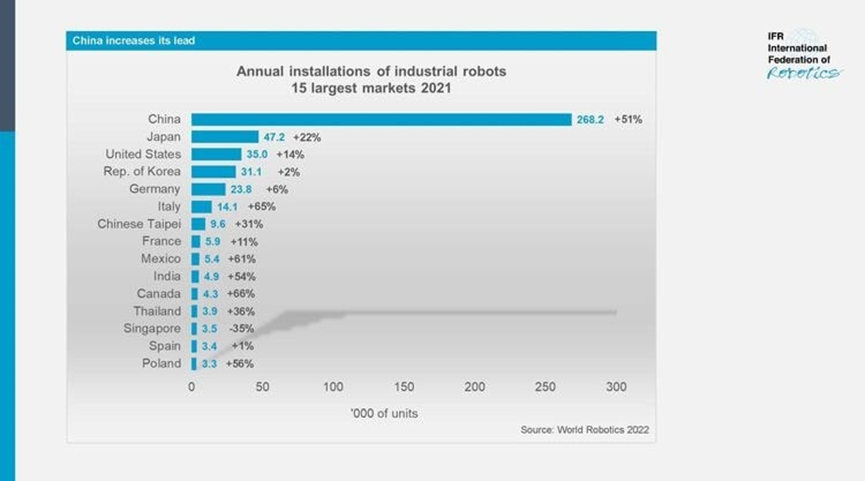廣東斯倍坦機器人有限公司
地址: 佛山市南海區桂城街道桂城工業園桂城平三路東側A3街區003號
郵箱: lcm@spacetime-axis-robot.com
網址: http://www.hfarts.cn
電話: 13902417042
微信: btloma

添加微信了解更多
2023-06-20 16:11:44
IFR recently released data showing that the number of newly installed industrial robots in the world reached 51.7 units in 2021, an increase of 31.2% year-on-year, a record high.
Despite the impact of the COVID-19 pandemic over the past two years, the global manufacturing supply chain has taken a big hit, but the demand for robots in key user areas in 2021 still shows a strong trend. As the manufacturing industry picks up, investment accelerates, and industrial robot production and orders have rebounded significantly.
The epidemic spread in the first half of the year, affecting the production and delivery of industrial robots, with the weakening of the impact of the epidemic, China's industrial robot industry is expected to gradually recover, in September 2022 output has returned to positive growth, the fourth quarter is expected to continue the growth trend.
China's industrial robot installed capacity accounted for more than half for the first time
Asia remains the world's largest market for industrial robots. In 2021, 74% of all newly deployed robots will be installed in Asia (70% in 2020).

China, the region's largest adopter, saw a strong 51% increase in installations to 268,000 units, 35% faster than the rest of the world excluding China, and for the first time accounted for more than half of the world's new industrial robot installations to 52%, nearly double the rate in the Americas and Europe.

In 2020-2021, the new installation of industrial robots in China is mainly concentrated in downstream industries such as electronics and automobiles, especially in the electronics and electrical industry, accounting for nearly one-third. China has always been a major producer of electronic products in the world, and the electronic and electrical industry as a large industrial robot application, in the face of the growth of the installed capacity of lithium, photovoltaic and other industries, still shows strong vitality and momentum, and has a strong pulling ability for the robot industry.
The automotive industry has always been an important driving force for the growth of robot demand, the explosion of the new energy vehicle market, resulting in the continuous expansion of industrial robot market demand, in 2021, China's new installed capacity in the automotive industry the fastest growth rate, reaching 97%, compared with 2020, almost double.
According to the data released by the National Bureau of Statistics, in September 2022, China's industrial robot production reached 43,000 units, with a year-on-year growth rate of 15.1%, and a quarter-on-quarter growth rate of 4.2%, while also pulling the cumulative industrial robot production growth rate from August's -10.5% to -7.1%, industrial robots are clearly showing signs of improvement, and the industry is expected to gradually recover.
The transformation and upgrading of industrial robots in the manufacturing industry saw steady growth
In terms of the popularity of robots on production lines, China still lags behind manufacturing powers such as the United States, Japan and Germany. With the supply of cheap labor shrinking at home and wages rising, factories need to adapt to the new reality by using more robots to fill a widening gap in the labor market and reduce costs, reducing the number of Western companies relocating production lines to other emerging markets. Automation has helped Chinese factories focus more on high-end manufacturing tasks, most of which are more precise than most humans can handle, while the robots themselves have become cheaper and more adaptable.
Despite China's growing robotics industry, most of the industrial robots installed last year were manufactured overseas, mainly in Japan. Hisaku Oka, head of Yaskawa Electric China, a Japanese robot manufacturer, believes that the speed of robot adoption in China reflects the economic benefits brought by enterprises' willingness to try new technologies, changes in the labor market and improvements in robotics, which means that China may be entering a period of robot application boom. It is estimated that by 2030, there will be 3.2 million to 4.2 million industrial robots on production lines in China.
China's experience in the last two to three years also highlights the advantages of automation. At the end of 2021, 15 departments such as the Ministry of Industry and Information Technology, the National Development and Reform Commission, and the Ministry of Science and Technology issued the "14th Five-Year Plan" for the Development of the robot industry, deploying the high-quality development direction of the robot industry from multiple levels such as technology upgrading and application expansion. China advocates reducing dependence on overseas markets and expanding the proportion of local enterprises in the global supply chain. Robots are crucial to achieving this goal.
Industrial chain coordination to promote better development of the industry
At present, a new round of scientific and technological revolution and industrial change is accelerating, China's robot industry, as an important carrier of emerging technologies and a key equipment field of modern industry, should play a more important role in leading the digital development of the industry, intelligent upgrading, and constantly introducing new industries and new formats. China's robot industry should:
First, improve the ability of industrial innovation, firmly grasp the development trend of robot technology, accelerate the research of robot common technology and the reserve of cutting-edge technology, promote the deep integration of a new generation of information technology and robot technology, and constantly improve the high-end and intelligent level of robots. Universities, research institutions and enterprises are encouraged to jointly carry out technological research, further improve the industrial chain, and promote innovation and development of the industry.
The second is to consolidate the foundation of industrial development, carry out actions to improve the key foundation of robots, improve the standards, testing and certification system, support the joint research of production, university and research, accelerate the completion of special materials, core components, processing technology and other industrial weaknesses, and create more high-end intelligent products.
The third is to increase the supply of high-end products, meet the needs of key industries, and promote the development of high-end robot products. In the fields of agriculture, construction, medical care, mining and other fields, we will actively explore the promotion mode of "reveal the list and take the lead", encourage user units to take the lead, cooperate with robot enterprises, universities, research institutes and other relevant units, and jointly break through key technologies such as robot research and development, production, testing, and application, and form a core technology production capacity with stable quality.
The fourth is to expand the depth of application, implement the "robot +" application action, organize the precise connection of production and demand, accelerate the popularization and promotion of mature scenes, increase product innovation in emerging fields, strengthen the characteristic application of segmented fields, and help the digital intelligent transformation and upgrading of various industries.
Finally, optimize the industrial organizational structure, support enterprises to deeply cultivate subdivided industries, and accelerate the growth of specialized and special new "small giant" enterprises. Encourage industry backbone enterprises to play a leading role in building an integrated development ecosystem for large, small and medium-sized enterprises in the fields of machine, parts and system integration.
Sum up
In 2021, the global economy faces many challenges, including high energy prices, tight supply chains for raw materials and electronic components, geopolitical uncertainties, restrictions on business activities and exchanges, and labor shortages, but these issues have brought broader development space for the industrial robot field, and market demand has reached a new high. The rapid growth in Chinese demand has been particularly impressive. It can be expected that China, as the largest consumer market for industrial robots, will continue to be an important driving force for the development of the global robot industry in the future.